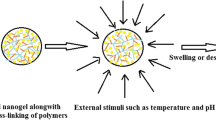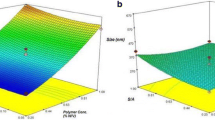Abstract
The morphology of gelatin nanoparticles loaded with three different drugs (Tizanidine hydrochloride, Gatifloxacin and Fluconazole) and their characteristics of entrapment and release from gelatin nanoparticles were investigated by the analysis on nanoparticle size distribution, SEM and FT-IR in this study. The particles were prepared by nanoprecipitation using water and ethanol as a solvent and a nonsolvent, respectively. The exclusion of a crosslinking agent from the procedure led the system to have an irregularly-shaped morphology. Nonetheless, the uncrosslinked case of Gatifloxacin loading generally led to a more homogeneous population of nanoparticles than the uncrosslinked case of Tizanidine hydrochloride loading. No loading was achieved in the case of Fluconazole, whereas both Tizanidine hydrochloride and Gatifloxacin are observed of being capable of being loaded by nanoprecipitation. Tizanidine hydrochloride-loaded, blank and Gatifloxacin-loaded nanoparticles yielded, under crosslinked condition, 59.3, 23.1 and 10.6% of the used dried mass. The crosslinked Tizanidine hydrochloride-loaded particles showed the loading efficiency of 13.8%, which was decreased to 1.1% without crosslinking. A crosslinker such as glutaraldehyde is indispensable to enhance the Tizanidine hydrochloride-loading efficiency. To the contrary, the Gatifloxacin-loading efficiency for crosslinked ones was lower by a factor of 2–3 times than that for uncrosslinked ones. This is due to the carboxylic groups of Gatifloxacin and the aldehyde groups of glutaraldehyde competing with each other during the crosslinking process, to react with the amino groups of gelatin molecules. The loading efficiency of gelatin nanoparticles reported by other investigators greatly varies. Nevertheless, the loading efficiency reported by us is in good agreement with the drug-loading data of gelatin nanoparticles reported by other investigators. The 80% of loaded Tizanidine hydrochloride was released around 15 h after start-up of the release experiment, while the 20% of loaded Gatifloxacin was released more rapidly, as free Gatifloxacin, than the loaded Tizanidine hydrochloride and it showed the trend of sustained slow release during the remaining period of its release experiment. Furthermore, the result of comparative FT-IR analysis is consistent to that of the corresponding drug release study.















Similar content being viewed by others
References
Mohanraj VJ, Chen Y (2006) Nanoparticles–a review. Trop J Pharm Res 5(1):561–573
Reis CP, Neufeld RJ, Ribeiro AJ, Veiga F (2006) Nanoencapsulation I. Methods for preparation of drug-loaded polymeric nanoparticles. Nanomed Nanotech Bio Med 2:8–21
Wade A, Weller PJ (1995) Hand book of pharmaceutical excipients, 2nd edn. Pharmaceutical Press, London, p 199
Coester CJ, Langer K, Briesen HV, Kreuter J (2000) Gelatin nanoparticles by two step desolvation a new preparation method, surface modifications and cell uptake. J Microencapsul 17(2):187–193
Zwiorek K (2006) Gelatin Nanoparticles as Delivery System for Nucleotide-Based Drugs. PhD Dissertation, Ludwig-Maximilians-University, München
Lu Z, Yeh TK, Tsai M, Au JLS, Wientjes MG (2004) Paclitaxel-loaded gelatin nanoparticles for intravesical bladder cancer therapy. Clin Cancer Res 10:7677–7684
Bilati U, Allemann E, Doelker E (2005) Development of a nanoprecipitation method intended for the entrapment of hydrophilic drugs into nanoparticles. Eur J Pharm Sci 24:67–75
Guerrero DQ, Allemann E, Fessi H, Doelker E (1998) Preparation techniques and mechanisms of formation of biodegradable nanoparticles from preformed polymers. Drug Dev Ind Pharm 24(12):1113–1128
Mahadik KR, Paradkar AR, Agrawal H, Kaul N (2003) Stability-indicating HPTLC determination of tizanidine hydrochloride in bulk drug and pharmaceutical formulations. J Pharma Biomed Anal 33:545–552
Rathore MS, Majumdar DK (2006) Effect of formulation factors on in vitro transcorneal permeation of gatifloxacin from aqueous drops. AAPS Pharm Sci Tech 7(3):57
Venugopal K, Saha RN (2005) New, simple and validated UV spectrophotometric methods for the estimation of gatifloxacin in bulk and formulations. Il Farmaco 60:906–912
Kaliamurthy J, Nelson Jesudasan CA, Geraldine P, Parmar P, Kalavathy CM, Thomas PA (2005) Comparison of in vitro susceptibilities of ocular bacterial isolates to gatifloxacin and other topical antibiotics. Ophthalmic Res 37:117–122
Marciniec B, Dettlaff K, Jaroszkiewicz E, Bafeltowska J (2007) Radiochemical stability of fluconazole in the solid state. J Pharm and Biomed Anal 43:1876–1880
Cascone MG, Lazzeri L (2002) Gelatin nanoparticles produced by a simple w/o emulsion as delivery system for methotrexate. J Mater Sci 13:523–526
Bajpai AK, Choubey J (2006) Design of gelatin nanoparticles as swelling controlled delivery system for chloroquine phosphate. J Mater Sci Mater Med 17:345–358
Leo E, Cameroni R, Forni F (1999) Dynamic dialysis for the drug release evaluation from doxorubicin-gelatin nanoparticles conjugates. Int J Pharma 180:23–30
Vandervoort J, Ludwig A (2004) Preparation and evaluation of drug-loaded gelatin nanoparticles for topical ophthalmic use. Eur J Pharm Biopharm 57:251–261
Kaul G, Amiji M (2002) Long-circulating poly(ethylene glycol)-modified gelatin nanoparticles for intracellular delivery. Pharm Res 19(2):1061–1067
Saxena A, Sachin K, Bohindar HB, Verma AK (2005) Effect of molecular weight heterogeneity on drug encapsulation efficiency of gelatin nanoparticles. Colloids Surf B 45:42–48
Dashora K, Saraf S, Saraf S (2005) Spectrophotometric method for the determination of Tizanidine hydrochloride in solid dosage forms. Orient J Chem 21(3):533–536
Dashora K, Saraf S, Saraf S (2006) In vitro studies of tizanidine controlled-release microcapsular matrices. Pak J Pharm Sci 19(3):177–181
Goger NG, Aboul-Enein HY (2001) Quantitative determination of fluconazole in capsules and IV solutions by UV spectrophotometric methods. Anal Lett 34(12):2089–2098
Tu LS, Dehghani F, Foster NR (2002) Micronisation and microencapsulation of pharmaceuticals using a carbon dioxide antisolvent. Powder Technol 126:134–149
Liao I-C, Wan ACA, Yim EK, Leong KW (2005) Controlled release from fibers of polyelectrolyte complexes. J Control Release 104:347–358
Acknowledgments
This research was supported (in part) by the Daegu University Research grant, 2010.
Author information
Authors and Affiliations
Corresponding author
Rights and permissions
About this article
Cite this article
Lee, E.J., Khan, S.A., Park, J.K. et al. Studies on the characteristics of drug-loaded gelatin nanoparticles prepared by nanoprecipitation. Bioprocess Biosyst Eng 35, 297–307 (2012). https://doi.org/10.1007/s00449-011-0591-2
Received:
Accepted:
Published:
Issue Date:
DOI: https://doi.org/10.1007/s00449-011-0591-2




